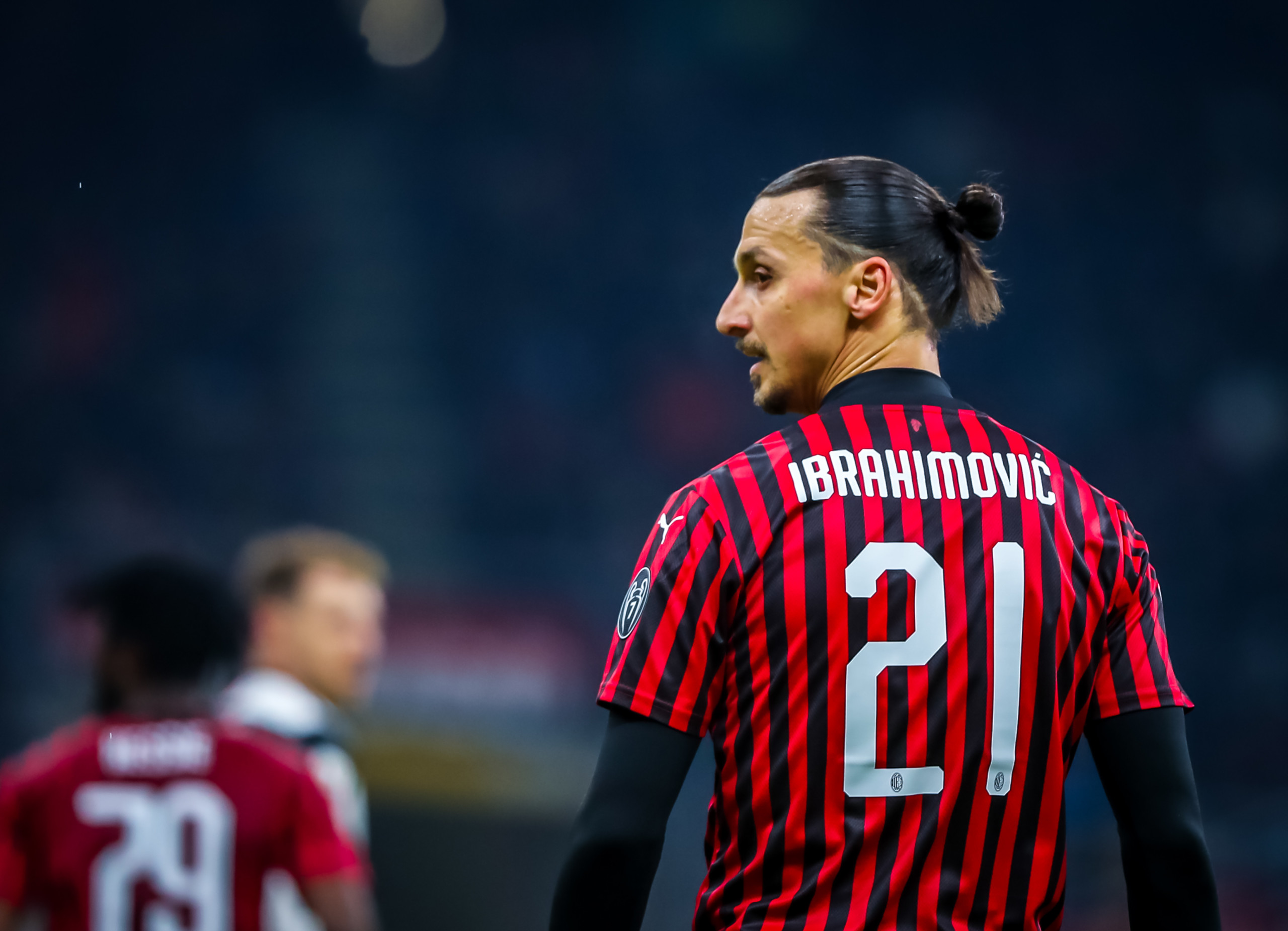According to Transfermarkt, Serie A clubs spent €214.35 million during the January transfer window, a record that blew apart the €153.90 million spent just a year ago. Four clubs alone (Napoli, Inter, Fiorentina, and Juventus, who only bought Parma’s sensation Dejan Kulusevski) invested about 70% of that amount. But let's take a look at the teams that have made moves that should be relevant to the outcome of this season and, perhaps never as much as before, to future ones.
AC Milan
AC Milan’s January market campaign marked an important transition; they sold two of the most important players in the squad, Krzysztof Piątek and Suso, and continued with the cost reduction policy they adopted last summer. To make a long story short: five first-team players left and five less expensive and/or more suitable players arrived. The club made a €24 million profit. To replace the Polish forward, who left for Herta Berlin for a fee of €27 million, came none other than superstar free agent Zlatan Ibrahimović. At 38, his return is definitely considered a short-term boost, but one that has had an extremely positive effect on AC Milan's season; they collected 11 points in the first 5 games after his return, before losing to Inter in the Milan Derby. The club adopted a completely different strategy to replace Suso, who went to Sevilla on loan with an obligation to buy on the fulfillment of certain conditions that have not been officially disclosed. 20-year-old Alexis Saelemaekers came in on loan from Anderlecht with a right of purchase after this season. Like Suso, he is a right-winger, but compared to the Spaniard he is equally skilled with both feet, and can also play as a fullback. 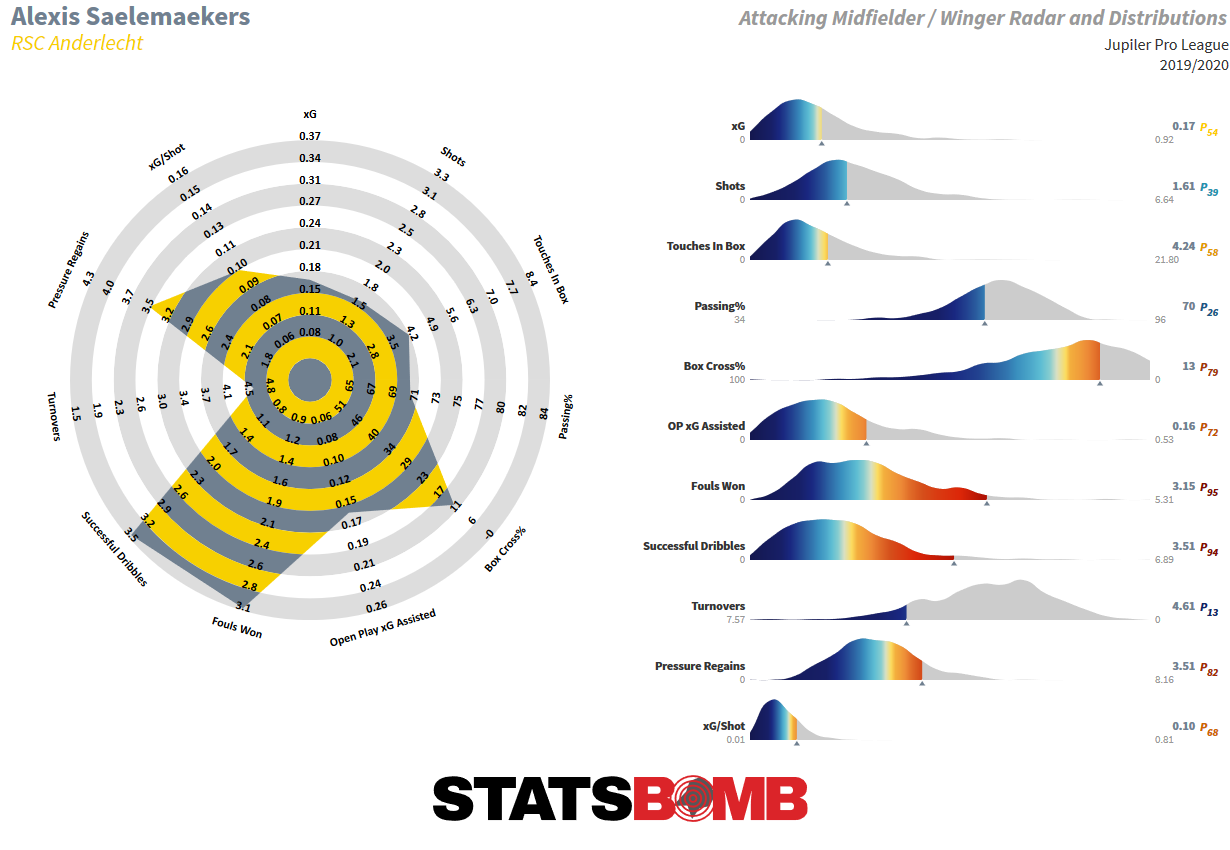 He was one of the best dribblers in the Belgian first division, and despite not being a household name like Ibra, he's a good prospect that can potentially be a strong alternative to both Ante Rebić and Andrea Conti. Chief football officer Zvonimir Boban and technical director Paulo Maldini offloaded Ricardo Rodríguez and Pepe Reina and replaced them by bringing in Asmir Begović on loan and calling back Diego Laxalt from Torino. Finally, after a series of injuries that compromised his career at AC Milan, Mattia Caldara returned to Bergamo where he had done so well, while Simon Kjaer, barely played by Atalanta coach Gian Piero Gasperini, took the opposite route.
He was one of the best dribblers in the Belgian first division, and despite not being a household name like Ibra, he's a good prospect that can potentially be a strong alternative to both Ante Rebić and Andrea Conti. Chief football officer Zvonimir Boban and technical director Paulo Maldini offloaded Ricardo Rodríguez and Pepe Reina and replaced them by bringing in Asmir Begović on loan and calling back Diego Laxalt from Torino. Finally, after a series of injuries that compromised his career at AC Milan, Mattia Caldara returned to Bergamo where he had done so well, while Simon Kjaer, barely played by Atalanta coach Gian Piero Gasperini, took the opposite route.
Napoli
Napoli's Serie A season is now seriously compromised, if not already over, and Aurelio De Laurentiis' club's winter campaign is just the preamble to an upcoming revolution that will be carried out in the summer. Carlo Ancelotti, who preferred a fluid 4-4-2, was replaced by his former player Gennaro Gattuso. The former AC Milan coach immediately shifted to 4-3-3, but with only four midfielders on the roster, he requested the arrival of two reinforcements. Sporting director Cristiano Giuntoli brought in both Diego Demme and Stanislav Lobotka. Demme, named after Napoli legend Diego Maradona, contributed immediately, offering stability to his new team’s build-up play. Albeit from a very small sample (2.7 90s), he is the Napoli player with the highest xG build-up. 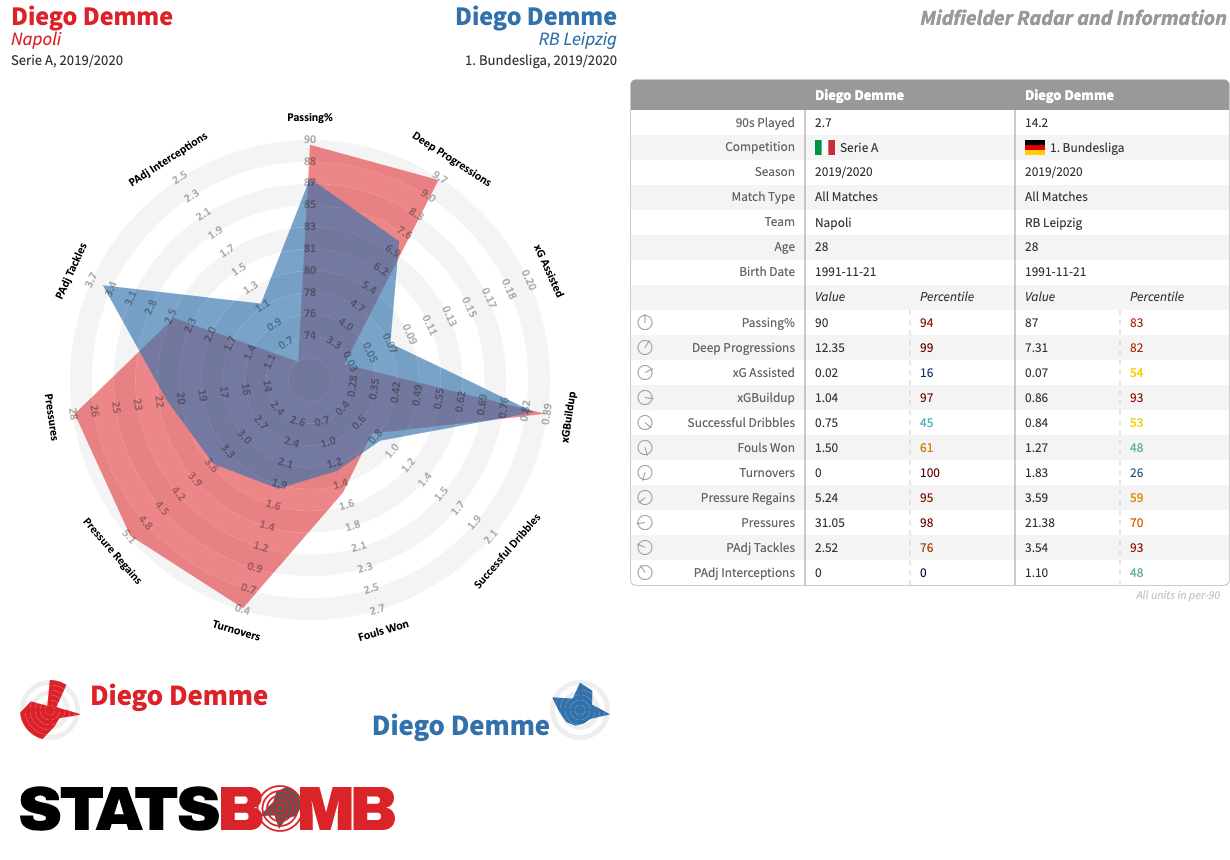 He also immediately put his engine to work to help the team's defense, offering Gattuso another midfielder with ball-winning potential besides Allan, who has played a minor role this season and could leave in July, as could Fabián Ruiz. Considering they paid just €12 million (plus bonuses), Demme is a great purchase for a Napoli team desperate for a midfielder of his kind. On the other hand, the signing of Lobotka, for which they paid a starting fee of €20M, plus €4 million in potential bonuses — pretty much double the price of Demme — isn't as impressive.
He also immediately put his engine to work to help the team's defense, offering Gattuso another midfielder with ball-winning potential besides Allan, who has played a minor role this season and could leave in July, as could Fabián Ruiz. Considering they paid just €12 million (plus bonuses), Demme is a great purchase for a Napoli team desperate for a midfielder of his kind. On the other hand, the signing of Lobotka, for which they paid a starting fee of €20M, plus €4 million in potential bonuses — pretty much double the price of Demme — isn't as impressive. 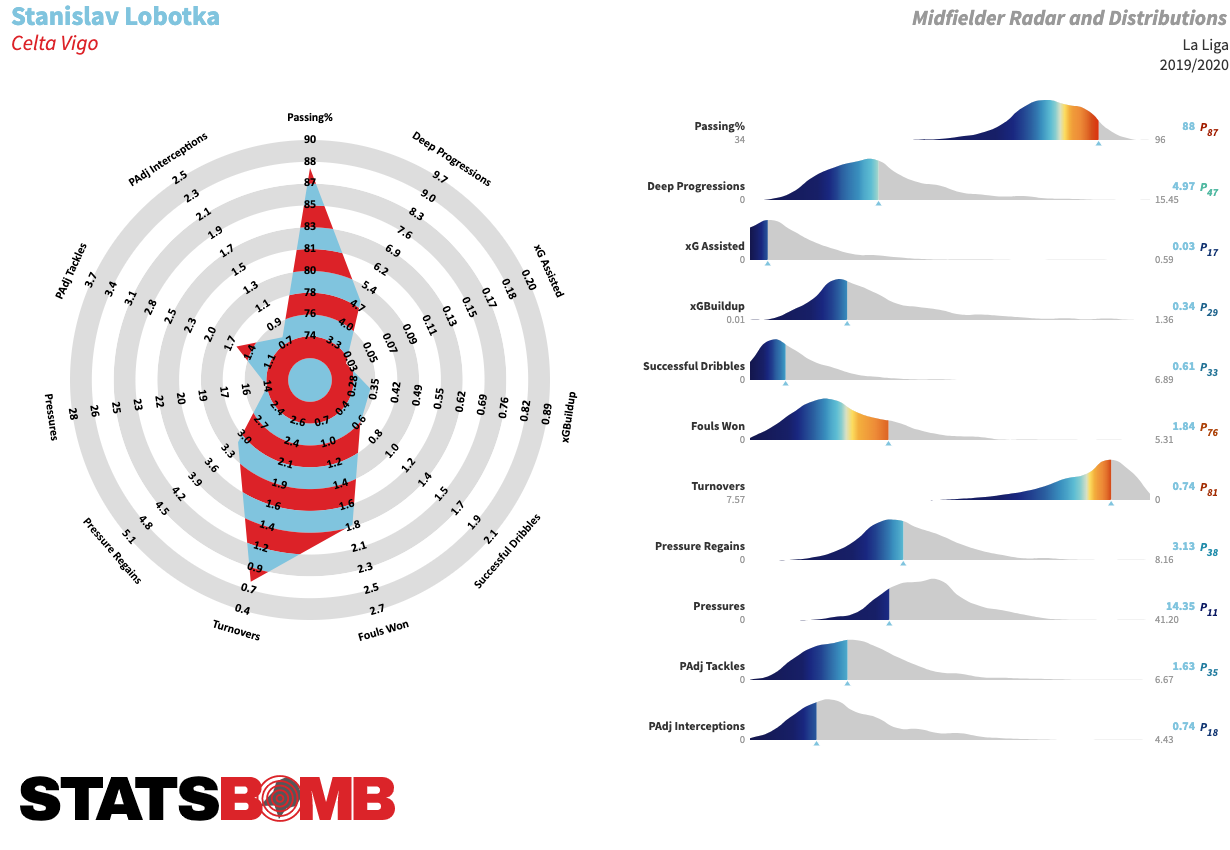 During the last two seasons at Celta Vigo, Lobotka clearly has not developed into a better player, nor does he represent an upgrade on the rest of their midfielders. If Napoli were looking for a number 8 able to consolidate possession, Lobotka fits the profile, but for that amount of money, they could have found better alternatives next summer. Napoli also signed Inter’s Matteo Politano for €25 million. The Italian winger is potentially a replacement for both José Callejón and Dries Mertens, who at this point seem sure to leave, but in reality, his profile is more that of a lite Lorenzo Insigne.
During the last two seasons at Celta Vigo, Lobotka clearly has not developed into a better player, nor does he represent an upgrade on the rest of their midfielders. If Napoli were looking for a number 8 able to consolidate possession, Lobotka fits the profile, but for that amount of money, they could have found better alternatives next summer. Napoli also signed Inter’s Matteo Politano for €25 million. The Italian winger is potentially a replacement for both José Callejón and Dries Mertens, who at this point seem sure to leave, but in reality, his profile is more that of a lite Lorenzo Insigne. 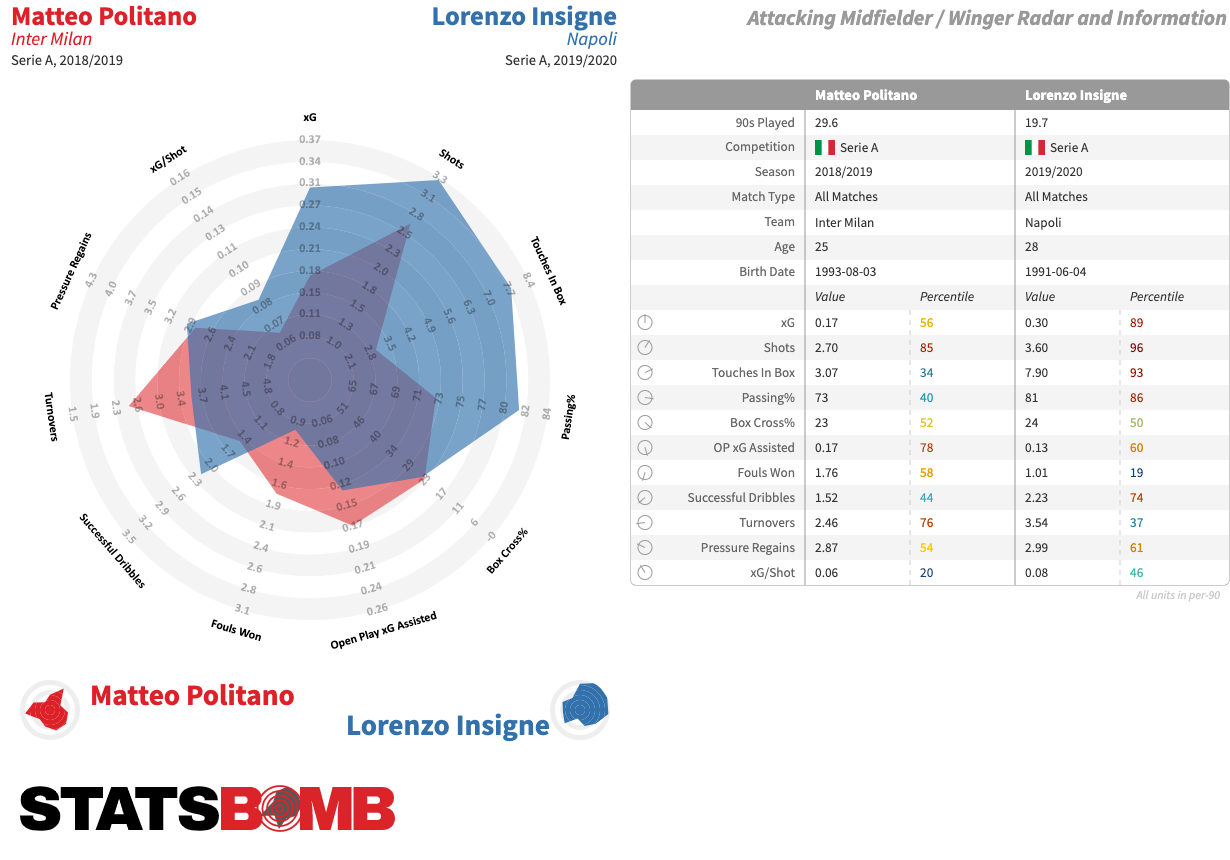 If we look at his 2018–19 output (Conte barely used him this season), he's just about average at dribbling, tends to shoot the ball often (you can decide if this is a positive for a winger) and is quite good at creating chances for his teammates. His spell at Inter was not particularly positive and it remains to be seen if playing on the opposite side of Insigne will enhance or hinder his play. As the icing on the cake, Napoli also purchased Hellas Verona centre back Amir Rahmani and SPAL striker Andrea Petagna for a combined fee of €31 million, but despite being potentially useful to the struggling side, they were both loaned back to their former teams until next season.
If we look at his 2018–19 output (Conte barely used him this season), he's just about average at dribbling, tends to shoot the ball often (you can decide if this is a positive for a winger) and is quite good at creating chances for his teammates. His spell at Inter was not particularly positive and it remains to be seen if playing on the opposite side of Insigne will enhance or hinder his play. As the icing on the cake, Napoli also purchased Hellas Verona centre back Amir Rahmani and SPAL striker Andrea Petagna for a combined fee of €31 million, but despite being potentially useful to the struggling side, they were both loaned back to their former teams until next season.
Inter
From September onwards Antonio Conte has not missed an opportunity to stress how weak he believes the depth of his roster was, ensuring those higher up knew of his displeasure. He was basically looking forward to new players coming in the January window. Considering the limited resources available due to FFP, CEO Giuseppe Marotta and technical director Piero Ausilio did their utmost, bringing in Ashley Young, Victor Moses and, most importantly, Christian Eriksen. Commenting on the arrivals of the two Brits, Conte said 'They are certainly not two Real Madrid starters', but their transition to Italian football should be quick, considering that wingback is the easiest role to play in his 3-5-2 (a clear blow to Valentino Lazaro, who was supposed to be the first choice in the role, but was loaned to Newcastle after six difficult months). Thus far they fit quite well, with one assist each already. Compared to the €23 million paid for Lazaro, both are low-risk investments: Young signed a six-month contract after leaving Manchester United on a free, while Moses was brought in from Chelsea on a six-month loan deal with an option to buy. And then there's Eriksen, the most exciting transfer of the window, whom they financed by selling Politano to Napoli. Surely one could argue whether paying €20 million in January for a player available for free in June is a smart move, but it's certain that Inter brought in a high-profile midfielder outmaneuvering potential competitors. 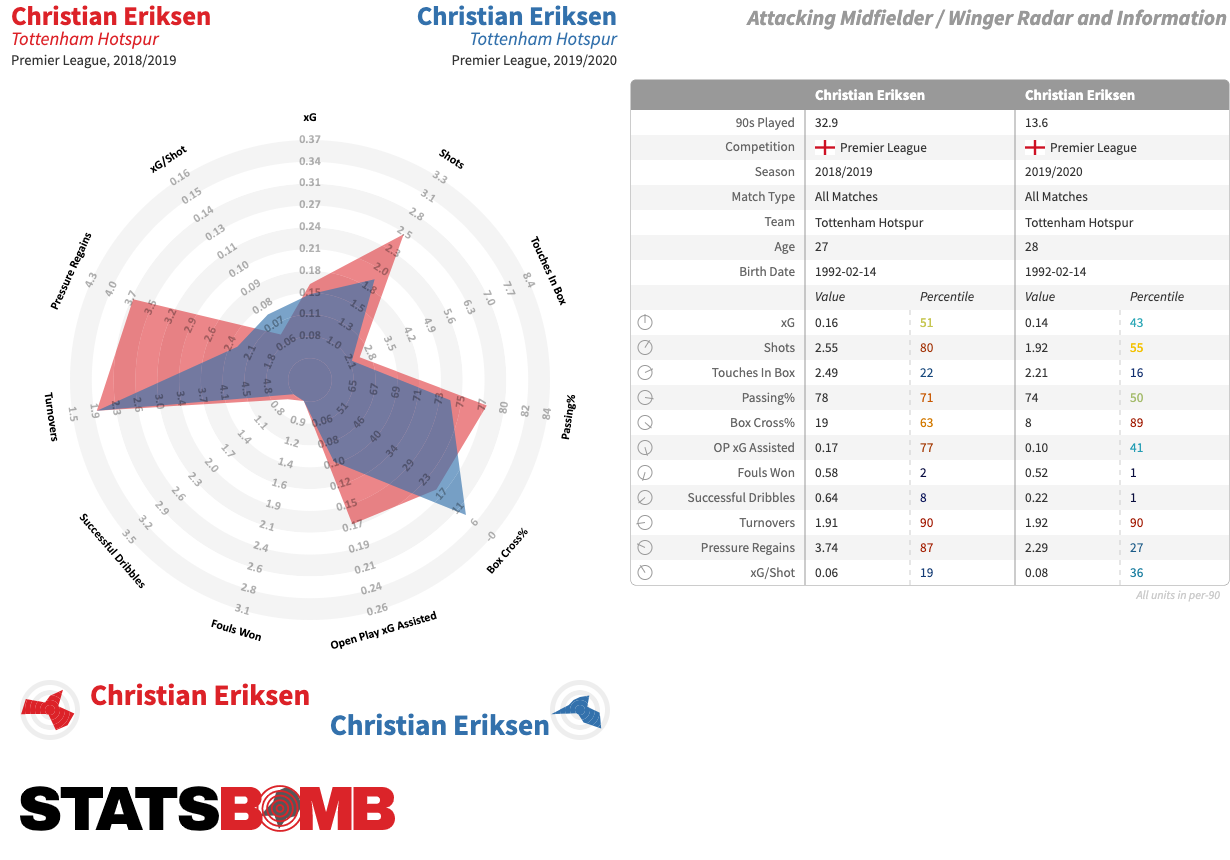 Although he doesn't have an obvious role in Conte's 3-5-2 and he played as attacking midfielder in the only game he started in Serie A so far, he could be the high-level creative number 8 that Inter desperately need so the forwards don't need to rely on their own ability to create a high volume of shots. Given the gap in points with Juventus is now closed, Eriksen is a weapon who could now help close the gap in quality, paving the way for Inter to truly have a shot at the scudetto.
Although he doesn't have an obvious role in Conte's 3-5-2 and he played as attacking midfielder in the only game he started in Serie A so far, he could be the high-level creative number 8 that Inter desperately need so the forwards don't need to rely on their own ability to create a high volume of shots. Given the gap in points with Juventus is now closed, Eriksen is a weapon who could now help close the gap in quality, paving the way for Inter to truly have a shot at the scudetto.
Fiorentina
Fiorentina, who had a startingly good run of form at the beginning of the season, was the most active team this winter, buying 6 players and splashing €70 million. They rolled the dice on these players, who could very well bring either future profit or add years of strength to their new team. La Viola's first coup was the return to Italy of Patrick Cutrone, who left Wolverhampton after just six months. He played few minutes in the Premier League, although his numbers in a very small sample are excellent. After going strikerless under Vincenzo Montella, newly appointed coach Beppe Iachini favored a more traditional approach, which shaped their market moves. After Cutrone, another striker, Christian Kouamé, joined from Genoa, although due to a serious knee injury, his debut won’t come that soon. The 22-year-old is not a forward who shoots a lot, but he is strong in aerial duels and also very fast and able to run into space. He might, therefore, be suitable to play alongside a pure striker such as Cutrone or Dušan Vlahović, or near a less conventional attack partner like Federico Chiesa. Owner Rocco Commisso also splashed out for Alfred Duncan, in the hope, he will offer more consistency in midfield than the evanescent Marco Benassi, and Igor Julio, a fast and technical centreback from SPAL, one of the few players who shone for the bottom-table team. 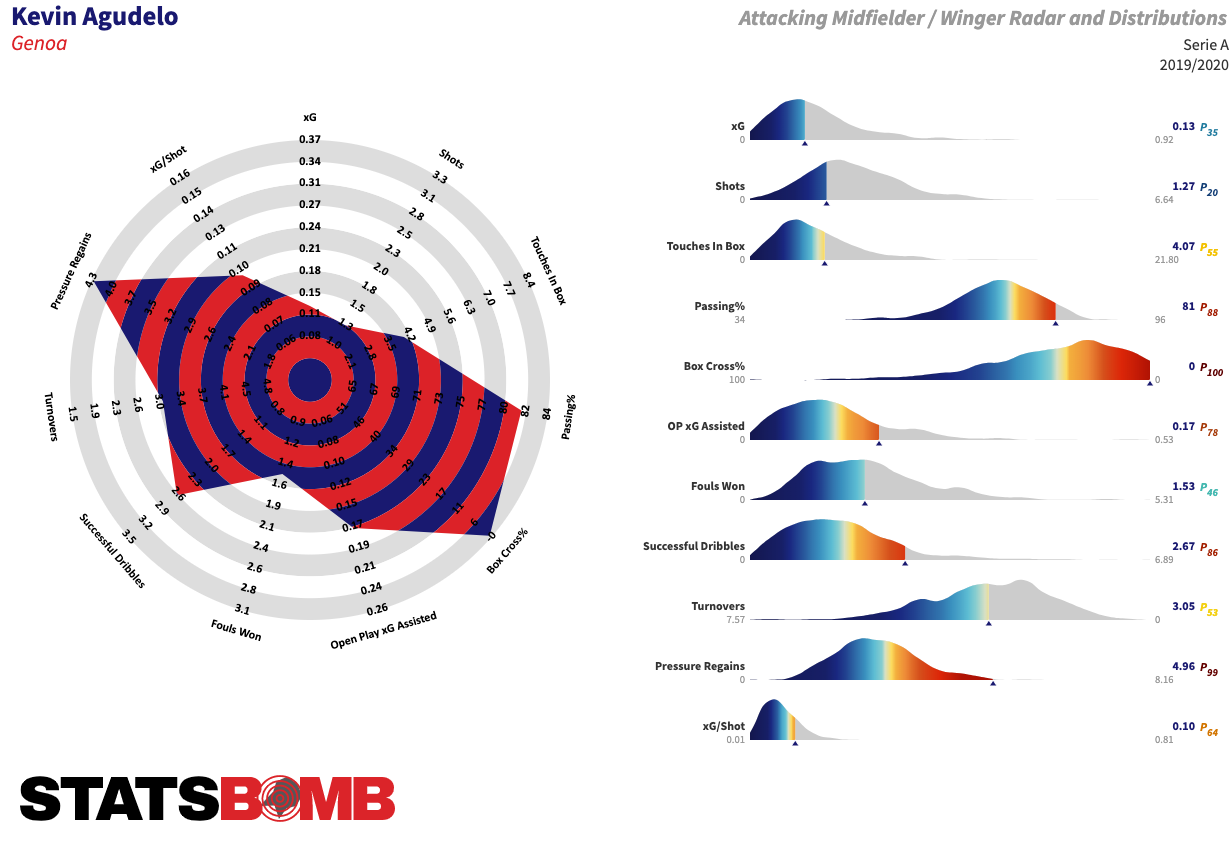 Fiorentina also beat out Napoli for Sofyan Amrabat's signature, although having played with Club Brugge and Hellas Verona this season, he'll be unable to play in this campaign, But the best transfer may be that of Kevin Agudelo. The loanee from Genoa is a versatile and dynamic midfielder who can play practically all midfield roles and on the right flank as well and could develop into an aggressive zone mover.
Fiorentina also beat out Napoli for Sofyan Amrabat's signature, although having played with Club Brugge and Hellas Verona this season, he'll be unable to play in this campaign, But the best transfer may be that of Kevin Agudelo. The loanee from Genoa is a versatile and dynamic midfielder who can play practically all midfield roles and on the right flank as well and could develop into an aggressive zone mover.
Two transfers to watch
This could end with a discussion on Verona's choice to sell two of its best players in January while keeping them until June, or a look at Genoa's Back to the Future transfer plan (they brought in, almost exclusively, only players who had already played with them), but I thought instead I'd leave you with two transfers to keep an eye on instead. 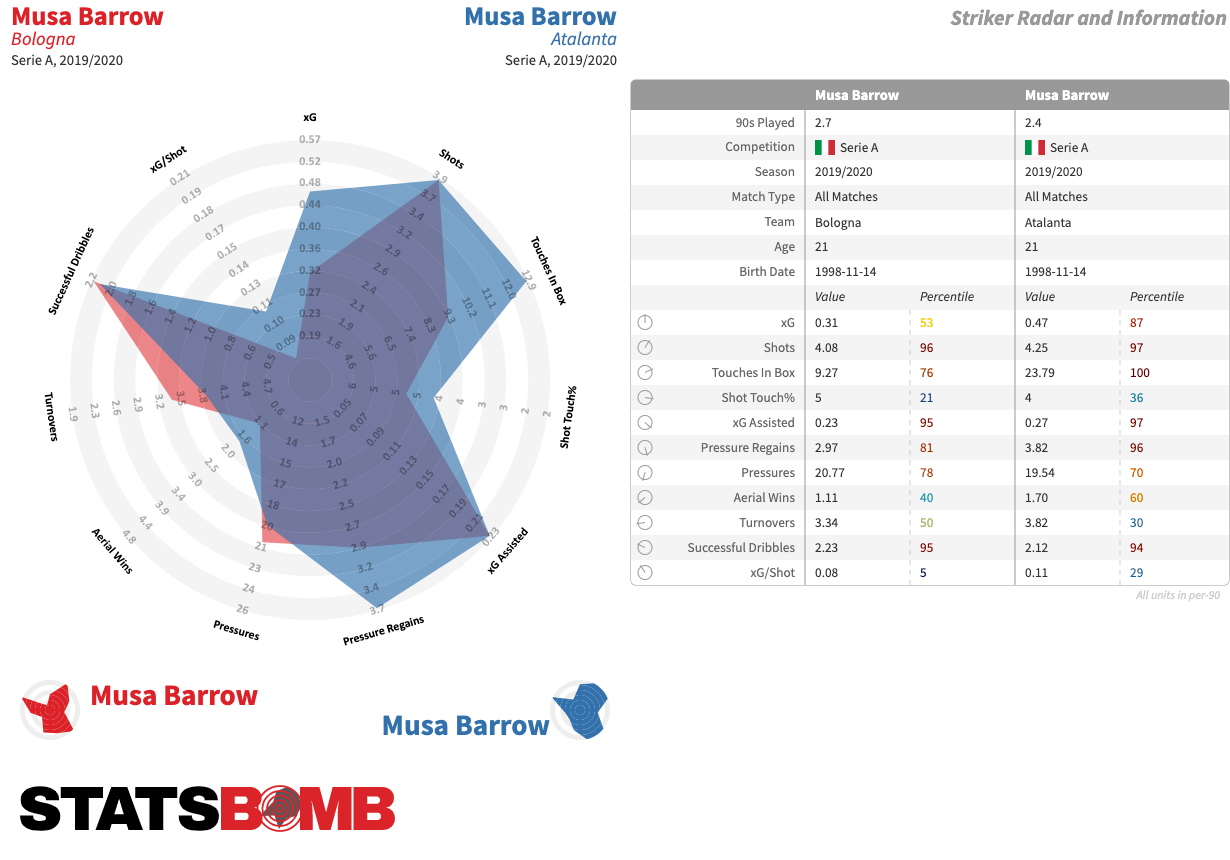 Musa Barrow is not new to the league, moving to Bologna from Atalanta to function as a starter for the Rossoblu. In his first three seasons as a professional, he has been an outlier in pretty much every relevant metric for a striker. Playing as a substitute and playing for Atalanta are surely two big reasons why, but his own traits shape the numbers, too. His time at Bologna already looks promising — in his first start he scored two goals against Roma — and has the potential to be one of the best strikers in the league. Bologna's sporting director, that old dog Walter Sabatini, snapped him up for €13 million.
Musa Barrow is not new to the league, moving to Bologna from Atalanta to function as a starter for the Rossoblu. In his first three seasons as a professional, he has been an outlier in pretty much every relevant metric for a striker. Playing as a substitute and playing for Atalanta are surely two big reasons why, but his own traits shape the numbers, too. His time at Bologna already looks promising — in his first start he scored two goals against Roma — and has the potential to be one of the best strikers in the league. Bologna's sporting director, that old dog Walter Sabatini, snapped him up for €13 million. 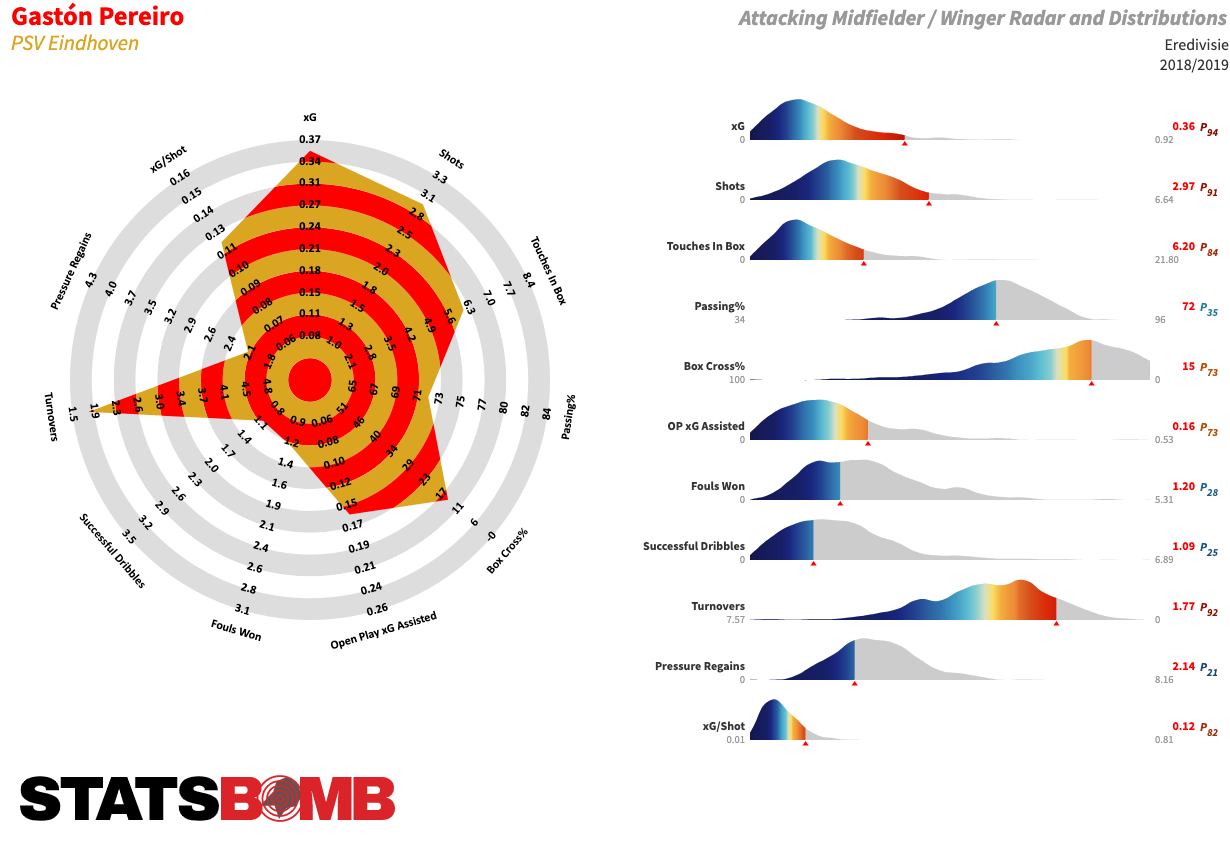 Meanwhile, Cagliari brought in Gastón Pereiro from PSV. The Uruguayan trequartista almost never saw the pitch this season due to a collarbone injury and a contract renewal that never came through. However, he had very good offensive production last season. Elite numbers in the Eredivise are not necessarily a guarantee of success in a top league, but the Sardinian club paid him just €2 million. It seems well worth the risk. Header image courtesy of the Press Association
Meanwhile, Cagliari brought in Gastón Pereiro from PSV. The Uruguayan trequartista almost never saw the pitch this season due to a collarbone injury and a contract renewal that never came through. However, he had very good offensive production last season. Elite numbers in the Eredivise are not necessarily a guarantee of success in a top league, but the Sardinian club paid him just €2 million. It seems well worth the risk. Header image courtesy of the Press Association
